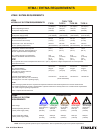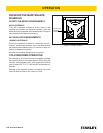
AL35 User Manual ◄ 5
Tool operators and maintenance personnel must always
comply with the safety precautions given in this manual
and on the stickers and tags attached to the tool and
hose.
These safety precautions are given for your safety. Re-
view them carefully before operating the tool and before
performing general maintenance or repairs.
Supervising personnel should develop additional pre-
cautions relating to the specic work area and local
safety regulations. If so, place the added precautions in
the space provided in this manual.
The AL35 Hydraulic Alternator will provide safe and de-
pendable service if operated in accordance with the in-
structions given in this manual. Read and understand
this manual and any stickers and tags attached to the
tool and hoses before operation. Failure to do so could
result in personal injury or equipment damage.
• Operator must start in a work area without bystand-
ers. Keep bystanders clear of your work area. The
operator must be familiar with the work area such as
excessive slopes and dangerous terrain conditions.
• Establish a training program for all operators to en-
sure safe operation.
• Do not operate the alternator unless thoroughly
trained or under the supervision of an instructor.
• Always wear safety equipment such as goggles, ear
and head protection, and safety shoes at all times
when operating the alternator.
• Never use tools near energized transmission lines.
Know the location of buried or covered services be-
fore starting your work.
• Do not overreach. Maintain proper footing and bal-
ance at all times.
• Do not inspect or clean the alternator while the hy-
draulic power source is connected. Accidental en-
gagement of the tool can cause serious injury.
• Always connect hoses to the alternator hose cou-
plers before energizing the hydraulic power source.
Be sure all hose connections are tight.
• Do not operate the alternator at oil temperatures
above 140 °F/60 °C. Operation at higher tempera-
tures can cause higher than normal temperatures
at the tool which can result in operator discomfort.
• Never transport or carry the alternator with the unit
energized and connected to electrical loads.
• Do not operate a damaged, improperly adjusted, or
incompletely assembled alternator.
• Observe local and national electrical codes for load
wiring. To prevent electrical shock from faulty equip-
ment, ground the alternator. If ground bonding is
required, connect a length of heavy wire between
the alternator ground terminal and the ground bond
point.
• Exercise reasonable caution to prevent electrical
shock; do not operate the alternator with wet hands.
• Do not operate the alternator in rain or snow. Do not
let the alternator get thoroughly wet.
• Do not connect the alternator to a building circuit.
This could cause damage to the alternator or to
electrical equipment in the building.
SAFETY PRECAUTIONS


















